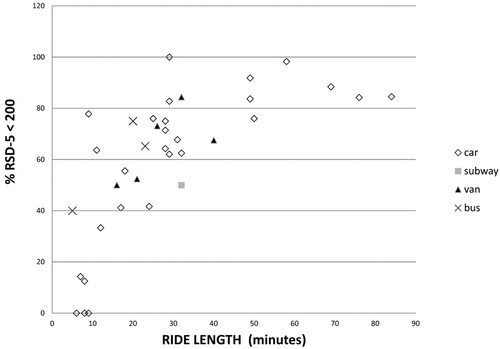Abstract
Chronic Obstructive Pulmonary Disease (COPD) frequently has a significant impact on patients’ everyday activity. Because of this, accurate measurement of daily activity is of particular interest. Although accelerometers are an objective means of measuring daily activity, these devices sense vibrations and erroneously score motor vehicle travel (MVT) as moderate physical activity. It is the objective of this study to develop a new method to analyze accelerometry data that would accurately classify MVT as non-acceleration, or sitting/standing. As sitting/standing has a different pattern of count-to-count variability than walking, we hypothesized that a rolling standard deviation (RSD), which is a measurement of volatility in the data, would more accurately classify periods of MVT than analysis based on activity counts alone. Twenty-two subjects with COPD were studied. A training set of 15% of the dataset was used to establish an RSD-threshold during MVT based on the upper 95%-confidence interval. The accuracy of the RSD thresholds were tested and presented as sensitivity, specificity and receiver operating curves. Results demonstrated high sensitivity and specificity suggesting that the RSD not only accurately classified MVT, but had a low rate of misclassification. The RSD analysis scored more MVT as sitting/standing than assessment by VMU alone. The accuracy of accelerometers to define the profile of daily activity in sedentary populations, such as those with COPD, is greatly improved.
| Abbreviations | ||
| COPD | = | chronic obstructive pulmonary disease |
| MVT | = | motor vehicle travel |
| RSD | = | rolling standard deviation |
| FEV1 | = | forced expiratory volume in 1 second |
| FVC | = | forced volumetric capacity |
| VA, NYHHCS | = | Veterans Administration, New York Harbor Health Care Services |
| VMU | = | vector magnitude units and RT3 - RT3 Research Tracker Accelerometer |
Introduction
The effects of chronic obstructive pulmonary disease (COPD) are not limited exclusively to structural remodeling of the lungs associated with pulmonary inflammation. Now considered a systemic chronic disease (Citation1), manifestations of COPD have an impact on the functioning of multiple organs. As in other chronic inflammatory diseases, weight loss, muscle wasting and tissue depletion are commonly seen in COPD patients. Given these systemic effects, it is not surprising that COPD has a profound effect on everyday activity. Patients who suffer from COPD spend more time sitting, less time walking and walk more slowly than their counterparts without lung disease (Citation2). COPD patients with lower profiles of daily activity are more likely to be hospitalized for acute exacerbations and have higher mortality than those patients with a more active lifestyle (Citation3). Because of this strong association between daily activity and health outcomes in COPD, there is interest in the accuracy of the measurement of physical activity.
One method to measure daily physical activity is with accelerometers. Accelerometers are small, wearable devices that contain a piezoelectric element that generates an electrical output that is proportional to the acceleration that is applied to it. We have previously shown that accelerometers can estimate the speed of walking in patients with COPD (Citation4). This enhances their usefulness in measuring daily activity in sedentary populations. In addition to measuring body motion, they are also sensitive to vibration (Citation5). One major limitation of these devices is that counts generated from traveling in a motor vehicle are similar to those generated during moderate exertion. When worn by a person riding in a motor vehicle, the main source of activity counts are from the vibration of the vehicle as it travels down the road and not from physical motion generated by the wearer (Citation6, 7, Citation8).
Thus, recordings obtained from a subject who spends an appreciable time in a motor vehicle will tend to overestimate activity levels. This is a particular concern in chronically ill populations that engage in little physical activity, as motor vehicle travel (MVT) would incorrectly amplify their measured activity profile. Therefore, it is important to appropriately classify accelerometer output collected during MVT to that equivalent to sitting or standing, thus providing a more accurate assessment of the profile of daily activity.
We have observed that typical free-living walking activity in COPD subjects appears in accelerometer recordings as a series of abrupt movements, that is, as a series of steps. As such, the pattern generated has considerable count-to-count variability. On the other hand, activity counts generated during sitting or standing result in significantly less count-to-count variability. Thus, these findings suggest that free-living walking can be differentiated from sitting or standing in accelerometer data by analyzing count-to-count variability. One method to analyze this type of variability is by calculating a rolling (or moving) standard deviation (RSD) (Citation9). The RSD is a measure of spread or volatility.
By specifying the time frame to use, the RSD is calculated from the deviation of each data point from the overall average of included points. Data points within the selected time frame that have different values will result in a higher RSD. Data points with similar values will result in a lower RSD. When repeated throughout the dataset, the RSD can identify differing patterns of volatility. We hypothesized that MVT would have a different pattern of volatility than free-living walking and would have a count variability similar to what is observed during sitting or standing. By incorporating the RSD into the analysis of accelerometer data, MVT could be appropriately reclassified as sitting or standing as opposed to being classified as moderate exertion when analyzing data by activity counts alone.
The aims of this study were to: 1) establish the RSD-threshold that classifies MVT as sitting or standing in a cohort of patients with COPD and 2) test the accuracy of the identified threshold to correctly classify all periods of sitting and standing activity in daily living, including periods of MVT.
Methods and Materials
Subjects
Twenty-two subjects with COPD (FEV1 <70%, FEV1/FVC<70) were recruited from the pulmonary and primary care clinics at the Brooklyn campus of VA, NYHHCS. All subjects were ambulatory and traveled to the clinical area by motor vehicle (car, bus, subway and/or multi-person van). All subjects signed consent to participate. The study was approved by the local ethics committee. Funding for this study was provided by a Veteran's Administration Health Services Research and Development Nursing Research Initiative grant (NRI 07-33).
Protocol
Each subject was fitted with an RT3 Research Tracker Accelerometer (stayhealthy.com, Monrovia, California). This is a triaxial accelerometer the size of a pager that is worn on the hip. Acceleration output from the RT3 is defined in vector magnitude units (VMU). Subjects were asked to wear the accelerometer for the remaining portion of the day and to write down all periods of MVT on a diary card provided for this purpose. Activity monitoring ended at the time the subject removed the accelerometer. Accelerometers were initialized to collect activity data in one-minute intervals. Prior investigators have found poor subject compliance with documenting MVT over several days (Citation6, Citation10). Most subjects in these studies did not reliably record when they entered and left a motor vehicle. Our proposed study differs from this prior work in that we only studied subjects over one day. Accuracy of diary entries is markedly improved with shorter data collection periods (Citation6).
Data Analysis
Data from the RT3 accelerometer were downloaded to a personal computer. First, data were analyzed using methods outlined by Hecht et al. (Citation10) to determine whether the accelerometer was worn or not worn. All counts after the first identification that the accelerometer was not being worn were eliminated from analysis. A 5-minute RSD (RSD-5) was calculated from every 5 intervals of activity counts using data points from the two minutes preceding and the 2 minutes following the interval being scored.
Because activity counts are based on a “look-back” and “look-forward” fashion, it is anticipated that the first and last two-minutes of MVT will likely be misclassified by the RSD as these include intervals prior to and following MVT. In addition, because in the one-minute data collection mode the RT3 measures activity every second and records the sum of sixty counts, the first and last intervals may include activity that preceded and follow the MVT. Given these limitations, it is anticipated that the RSD will be more accurate for longer MVT rides than for shorter ones and that relatively short rides will be very poorly classified.
Statistical Analysis
Demographic data are presented as means ± SD and frequencies.
Two data sets were then created. First, 15% of the data set was used to estimate the RSD threshold that best predicted MVT. For this ‘Training Set,’ all of the periods indicated on the diary cards as MVT were isolated and an average RSD was calculated. The average RSD for each MVT was plotted against the duration of MVT (in minutes) to determine the impact of ride length on these methods. Thresholds to identify MVT were established from the mean and upper 95% confidence interval.
The remaining activity data (Test Set) was used to calculate the accuracy of the RSD. The RSD is expected to be low during sitting and/or standing as well as MVT. Therefore, a lower limit of VMU = 150 was used as the threshold for non-acceleration (all VMU < 150 considered sitting or standing). This threshold is based on prior work with the RT3 and observed periods of sitting and standing in subjects with COPD (Citation4) and work published on healthy subjects with the Tritrac-R3 D accelerometer, which is the predecessor to the RT3 (Citation11).
As MVT is expected to be sustained over many minutes, we suspected that requiring the RSD to be below threshold for several consecutive minutes may improve the rate of falsely classifying free-living as MVT. As such, we compared the accuracy of one, five, nine, fifteen and twenty-one consecutive minutes of RSD < threshold by calculating the sensitivity and specificity of each of these interval lengths and compared results using receiver operating curves. For comparison, the accuracy of the RSD calculated from three consecutive intervals was tested (RSD-3). Sensitivity is defined as the accuracy of the RSD to correctly classify activity counts as MVT; specificity is defined as accuracy of the RSD above threshold to avoid classifying counts as MVT when subjects were engaged in free-living activity.
The percent of MVT that was correctly classified as sitting or standing was compared between the RSD analysis and using VMU alone. Accuracy of the RSD analysis is defined as the percent of MVT with RSD < threshold determined in the first objective. Accuracy of the VMU analysis is defined as the percent of MVT with VMU < 150. Accuracy of both methods was plotted against the duration of MVT (in minutes) to determine the impact of ride length on these methods.
Results
Demographic description of the subject cohort is presented in . 22 subjects with COPD were recruited into the study. Overall, the COPD cohort had moderately severe obstructive disease (FEV1 predicted 54.1 ± 11.9) and relatively low BODE score (Citation12) (3.3 ± 2.5) indicating a low morbidity and mortality risk. There was no significant difference in demographic characteristics between the Training and Test groups.
Table 1. Demographic data
Average length of recording time was 6.9 ± 2.6 hours and included 62 motor vehicle trips (forty-four car rides, eight multi-person van rides, seven bus rides and three subway rides). Most subjects engaged in multiple motor vehicle rides over the course of their recording period. Average length of MVT ride was 31.2 ± 20.5 minutes (range 5–89 minutes). In total, there were 1904 minutes (31.7 hours) of MVT that comprised the analysis.
is a one-hour recording from one subject. The RSD of each five consecutive minutes is superimposed onto the activity data retrieved from the RT3 during a period of walking and sitting. The RSD is elevated during the two walking periods. In contrast, sitting is comprised of more uniform counts with VMU < 150; these have a smoother pattern and a lower RSD. is a 45-minute excerpt from an ambulatory recording that includes two periods of walking and one MVT ride. MVT produced a pattern in the RSD that is smoother than walking, as the accelerometer senses the vibration of the vehicle on the road and not its acceleration and deceleration. This is similar to the low variability seen during periods of sitting, but at an appreciably higher VMU average. The response lag of the RSD when subjects were transitioning between MVT and free-living activity is apparent in these figures.
Figure 1. Accelerometer recording of Walking and Sitting; 5-minute Rolling standard deviation superimposed over activity counts during a 1-hour recording of Walking and Sitting.
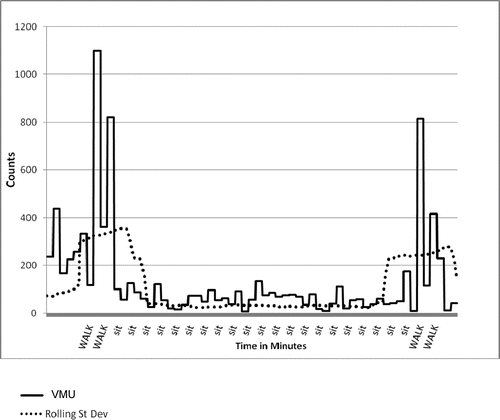
Figure 2. Accelerometer recording of Walking and Vehicular Travel; 5-minute Rolling standard deviation superimposed over activity counts during a 45-minute recording of walking and motor vehicle travel.
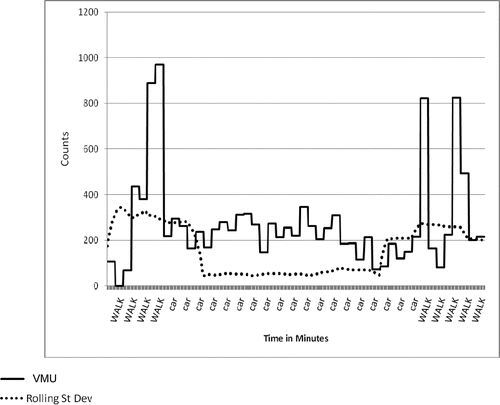
is an ambulatory recording from one subject. Along the x-axis, periods of MVT were transcribed from this subject's diary card. In this recording, all time periods identified as car rides have VMU > 150, which is greater than the threshold for activities that consist of non-acceleration. The RSD for these periods are all low, except for the first and last three to four minutes of each MVT period illustrating the transitions of activity into and out of the MVT. Thus, the RSD can classify these periods as MVT rather than free-living activity, which was consistent with this subject's diary.
Figure 3. A 6-hour Recording of Walking, Sitting and Car Ride in one COPD Subject; 5-minute Rolling standard deviation superimposed onto a 6-hour period of free-living. Car rides transposed from subject's diary. These periods have a consistent pattern of low count-to-count variability with low RSD, similar to the pattern generated during extended periods of VMU < 150 (sitting or standing).
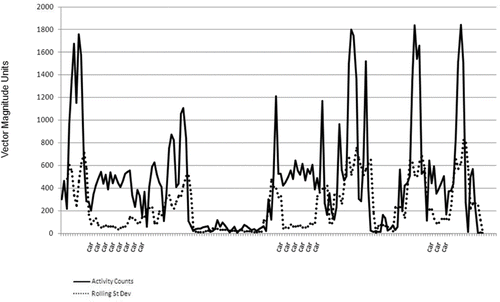
The training set was comprised of nineteen MVT rides from nine subjects. illustrates the relationship between average RSD of each of these rides and ride length: for rides less than approximately 15 minutes, the RSD has marked variability, reflecting the inclusion into the overall calculation of activity counts prior to and following travel time. Rides longer than 15 minutes have relatively similar values and appear to be reasonably free from inclusion of non-MVT intervals. Average RSD for these rides was 126 ± 34 (95% confidence interval = 194; range 75 –220). In comparison, average VMU for these rides = 196 ± 72 (range 86 –351), which is greater than the threshold for non-acceleration. Based on these findings, RSD thresholds 150 and 200 were compared in the prediction analyses on the remaining data set (Test Set).
Figure 4. Comparison of MVT Mean RSD and VMU to Ride Length; 5-minute Rolling standard deviation and average VMU for each ride in the Test Set compared to ride length. RSD and VMU are variable for rides longer than 15 minutes. For longer rides, only the RSD becomes less variable and is consistently below a threshold of 200.
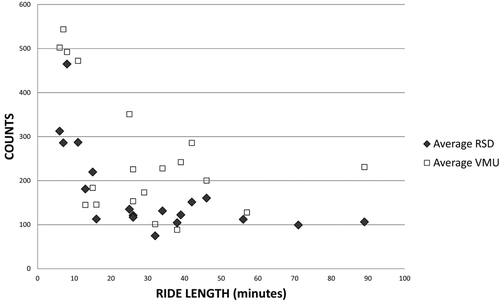
and present the performance of RSD at these thresholds. For each threshold, sensitivity and specificity are presented for a single minute with RSD < threshold to predict MVT and then for RSD < threshold for 5, 9, 15 and 21 consecutive minutes. Results show that an RSD calculated with 5 intervals offers only marginal improvement in prediction error over RSD calculated with three intervals.
Figure 5. ROC Curves for RSD Thresholds. Comparison of sensitivity and specificity for different RSD thresholds: RSD-5 –rolling standard deviation using 5 epochs; RSD-3 rolling standard deviation using 3 epochs. Comparisons are made using 1, 5, 9, 15 and 21 consecutive minutes with RSD < threshold.

Table 2. Accuracy of RSD to predict MVT
Although RSD < 150 demonstrated the best specificity (fewest intervals of free-living activity misclassified as MVT), the sensitivity was unacceptably low. As anticipated, specificity improved when more consecutive minutes were included in the analysis regardless of RSD threshold chosen. We propose that an RSD calculated with 5 intervals optimally predicts MVT in these COPD subjects and that nine consecutive minutes of RSD < 200 offers the best prediction of MVT (sensitivity = 0.73), while minimizing the false positive rate (specificity = 0.94). The RSD performed considerably better than using VMU alone: only 34.1 ± 26.8% of VMU during MVT were below 150.
Last, we assessed the impact of ride length on the accuracy of this threshold. plots the percentage of MVT in the Test Set with RSD < 200 for nine consecutive intervals against ride length. As illustrated, the RSD performs considerably better for longer motor vehicle rides than for shorter ones and that the RSD performance is equivocal for rides in cars, vans, buses or subways. Ride length did not have an effect on accuracy using VMU alone ().
Discussion
Although accelerometers provide an inexpensive, relatively easy way to collect information on daily activity in both active and sedentary populations, they have some important limitations. Since these instruments are sensitive to vibration, as commonly found when riding in a motor vehicle, their usefulness in distinguishing MVT from routine physical activity is greatly diminished. Thus, subjects who spend an appreciable amount of time riding in a motor vehicle will appear to have a higher activity profile than if MVT were correctly classified as sitting or standing. We have presented a new analysis technique that can detect and reclassify activity counts generated during MVT.
Our results demonstrate that the RSD was more accurate for MVT of longer duration. Because the RSD is based on five consecutive minutes, the first 4 and the last 3 minutes of sitting, standing or MVT may not be accurately classified by this analysis method as the calculation includes the activity that immediately preceded or followed the activity of interest. For instance, only 7 minutes of a 15-minute MVT ride may have a low RSD, resulting in an accuracy rate of approximately 47%.
Our findings confirmed this expectation as the RSD performed better for longer MVT rides. The ability of the RSD to correctly classify MVT less than 15 minutes was, in general, equivalent to the poor performance of using VMU alone. Misclassification of the longer rides is more likely to have the greatest clinical and research significance, which is where the RSD analysis has the greatest accuracy and potential utility. It is likely that the RSD could be applied to other accelerometers to detect MVT in activity recordings, although the specific thresholds would need to be established.
Our findings concur with those of other investigators. Masurier and Tudo-Locke (Citation13)noted that while no actual steps were taken during the MVT segments of their testing protocol, both their accelerometer and pedometer (step counter) erroneously detected locomotion. The erroneous counts were highly consistent between two different periods of MVT. This is confirmed by Bouten et al. (Citation14), who found that after correction from vibration produced by transportation, correlation between accelerometer output and calculations of metabolic rate improved from r = 0.58 to r = 0.73.
The threat to validity would likely be even more problematic when using these devices to assess daily activity in sedentary individuals, such as those with chronic disease with overall lower daily activity counts. In fact, Hecht et al. found a 16.2% decrease in average daily activity counts in a small subset of a COPD subjects when periods of riding in motor vehicles were reclassified in their analysis (Citation10). This highlights the importance of accurately detecting MVT in assessing daily activity in COPD subjects who are known to have very low activity profiles.
Troped et al. proposed a different analysis model to predict MVT in accelerometer data (Citation15). These investigators combined data from a global positioning system with an accelerometer to classify five modes of activity, including driving an automobile, in a population of healthy adults. Using discriminant functional analysis techniques, they were able to identify the combination of variables from both devices that optimally predicted activity mode.
Their analysis techniques were 88–96% accurate for identifying walking, running, bicycling and inline skating; 61% of MVT was accurately identified by their methods. Confusion between MVT and bicycling was attributed to congested driving conditions where vehicle speed could have been generated on a bicycle. Of note, the study protocol analyzed activity bouts of ten minutes. Our RSD analysis may not offer superior identification of MVT at this short ride length in very active healthy subjects.
Investigators have tried to establish cut points in accelerometer data for classification of light, moderate and vigorous activity. Crouter et al. (Citation16) noted that in a population of healthy and active subjects, “lifestyle” daily activities had erratic movement patterns, while locomotor activities (walking and running) yielded more consistent minute-to-minute counts. They calculated the coefficient-of-variation for 10-second consecutive accelerometer counts for a series of activities. These investigators found less count-to-count variability during running and walking than in other daily activities in this population.
Although it is likely that walking at a steady pace would have the same impact on the RSD as these investigators found in the calculation of the coefficient-of-variation, this type of activity is performed infrequently by typical COPD patients unless they are participating in a rehabilitation program. Our observation of data from COPD subjects riding in motor vehicles suggests that activity counts generated during MVT do not approach the intensity generated during this type of exercise and can be easily differentiated. Addition of a maximum speed during extended periods of low count variability may solve this issue. As there was no exercise performed by subjects in the cohort in this study, it was not possible to investigate this further.
This study has several other limitations. First, we did not collect information on which seat of the vehicle subjects occupied or whether the subjects were drivers or passengers, which may influence the accelerometer's interpretation of vehicular vibration, especially in multi-person vans and buses. We also did not collect data on what types of roadways the vehicles were driven. As such, the accuracy of this analysis may differ depending on whether the vehicle is traveling on city streets or on highways or during different traffic conditions. As the medical facility where this study was conducted is located in an urban setting near to major expressways, it is likely that this dataset included all types of roadways.
In summary, MVT longer than 15 minutes can be accurately classified in accelerometer output by calculating the count-to-count variability. The performance of the RSD was acceptable across different types of vehicles in this sedentary population. By reclassifying activity counts generated during MVT to counts equivalent to sitting or standing, the accuracy of accelerometers to define the profile of daily activity in COPD is greatly improved. This technique comprises a low burden of additional analysis and can be performed with commercial software commonly used by clinical researchers. To avoid misclassifying exercise in COPD patients, visual review of the data is recommended.
Declaration of interest
The authors report no conflicts of interest. The authors alone are responsible for the content and writing of the paper.
References
- Wouters EF, Creutzberg EC, Schols AM. Systemic effects in COPD. Chest 2002; 121:127S–130S.
- Pitta F, Troosters T, Spruit M, Probst VS, Decramer M, Gosselink R. Characteristics of physical activities in daily life in chronic obstructive pulmonary disease. Am J Respir Crit Care Med 2005; 171:972–977.
- Garcia-Aymerich J, Barreiro E, Farrero E, Marrades RM, Morera J, Anto JM. Patients hospitalized for COPD have a high prevalence of modifiable risk factors for exacerbation (EFRAM study). Eur Respir J 2000; 16:1037–42.
- Cohen M, Cutaia M. A novel approach to measuring activity in chronic obstructive pulmonary disease: using 2 activity monitors to classify daily activity. J Cardiopulm Rehabil Prev 2010; 30:186–194.
- Powell SM, Jones DI, Rowlands AV. Technical variability of the RT3 accelerometer. Med Sci Sports Exerc 2003; 35:1773–1778.
- Steele BG, Holt L, Belza B, Ferris S, Lakshminaryan S, Bucher DM. Quantitating physical activity in COPD using a triaxial accelerometer. Chest 2000; 117:1359–1367.
- Belza B, Steele BG, Hunziker J, Lakshminaryan S, Holt L, Buchner DM. Correlates of physical activity in chronic obstructive pulmonary disease. Nurs Res 2001; 50:195–202.
- Casaburi R. Activity monitoring in assessing activities of daily living. COPD: Journal of COPD 2007; 4:251–255.
- Ulrich J. (2011, September 29) Technical trading rules. Cran. R-Project. Retrieved December 2010 from http://cran.r-project.org/web/packages/TTR/TTR.pdf.
- Hecht A, Ma S, Porszasz J, Casaburi R. Methodology for using long-term accelerometry monitoring to describe daily activity patterns in COPD. COPD. J COPD 2009; 6:121–129.
- Sherman WM, Morris DM, Kirby TE, Petsoa RA, Smith FA, Fird DJ, Leenders F. Evaluation of a commercial accelerometer (Titrac-R3 D) to measure energy expenditure during ambulation. Int J Sports Med 1998; 19:43–48.
- Celli BR, Cote CG, Marin M, Casanova C, Montes des Oca M, Rendez RA, Pinto Plata V, Cabral HJ. The body-mass index, airflow obstruction, dyspnea and exercise capacity index in chronic obstructive pulmonary disease. N Engl J Med 2004; 350:1005–1012.
- Le Masurier GC, Tudor-Locke C. Comparison of pedometer and accelerometer accuracy under controlled conditions. Med Sci Sports Exerc 2003; 35:867–871.
- Bouten CV, Verboeket-va de Venne WP, Westerterp KR, Verduin M, Janssen JD. Daily physical activity assessment: comparison between movement registration and doubly labeled water. Journal of Applied Physiology 1996; 81:1019–1026.
- Troped PJ, Olivera MS, Matthews CE, Cromley EK, Melly SK, Craig BA. Prediction of activity mode with global positioning system and accelerometer data. Med Sci Sports Exerc 2008; 40:972–978.
- Crouter SE, Clowers KG, Bassett DR. A novel method for using accelerometer data to predict energy expenditure. J Appl Physiol 2006; 100:1324–1331.

